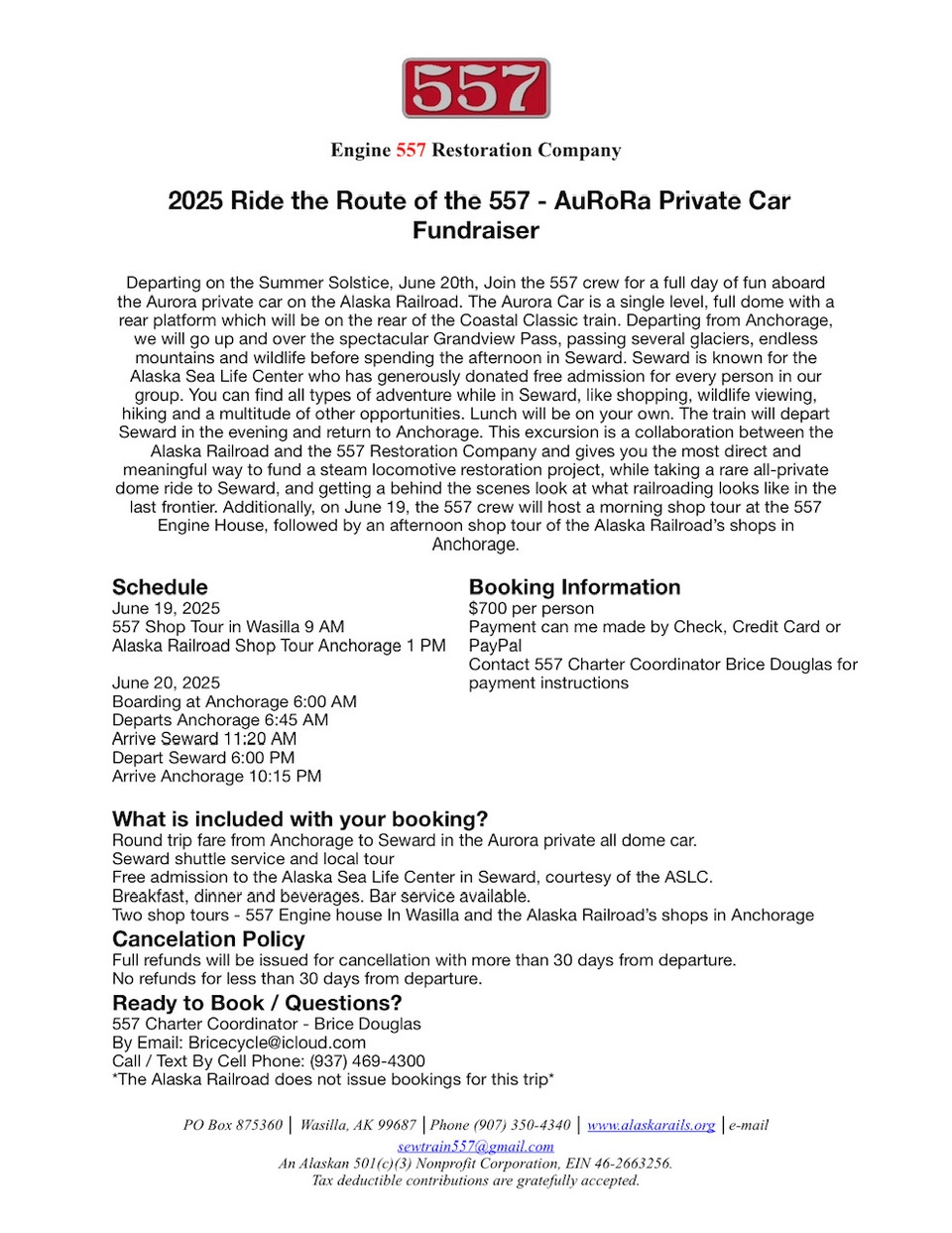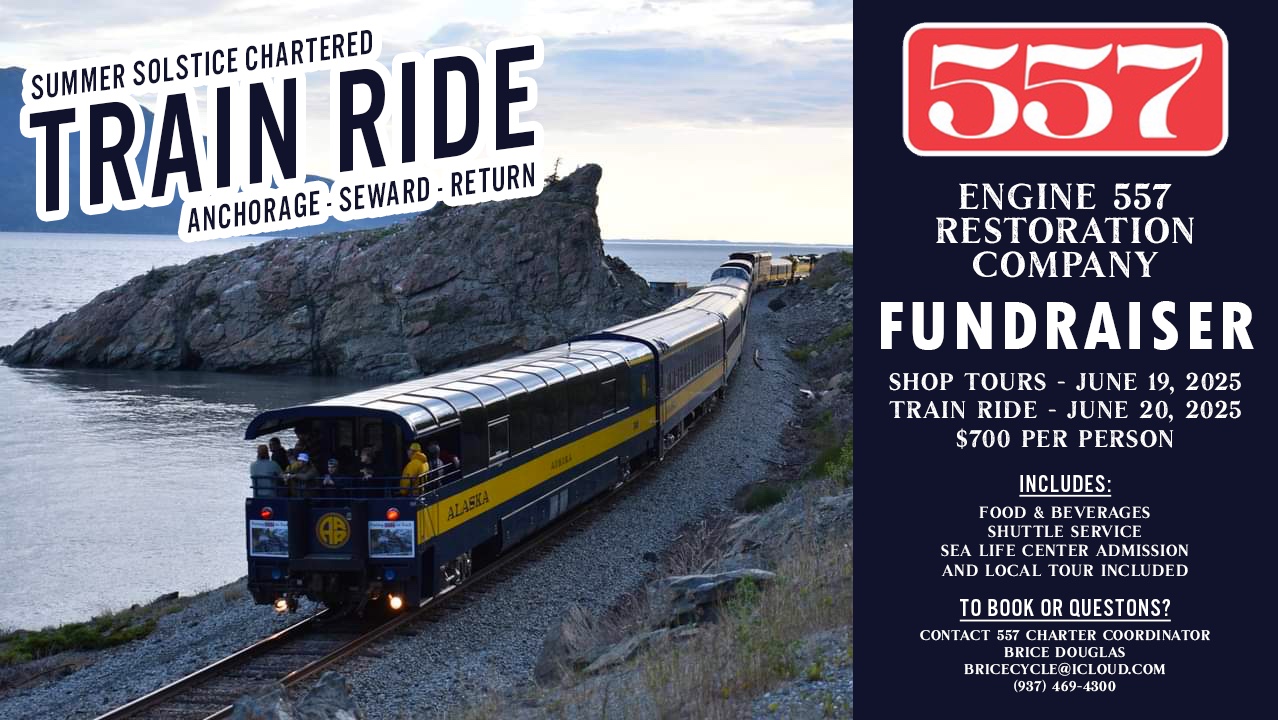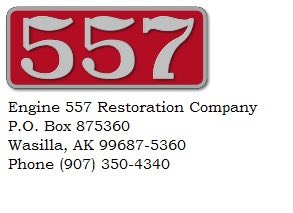Engine 557
Restoration Company
Progress Report March 2025
March 2025 came and went with just a dusting of snow, disappearing by noon. On the 31st the 557 yard basked in 58 ° F sun light in the winter that was not. Local fire service areas are looking at a serious fire season. Glad 557 will be burning clean used oil.
What other people say:
Erich Armpriester, Strasburg Railroad company, “The progress on #557 always looks great. I’m sure she’ll be a great performer once the top-notch overhaul is done.”
Brian Bundridge sent this historic photo of 557 enroute to scrapping. “I was going through my archives and happened to come across this picture of the 557 in Stacy Street Yard Dec 18, 2011. Great to see so much progress on the locomotive and hope to visit you all." Thanks, Brian for the photo. That was 557’s last stop before rescue, going to Monte Holm in Moses Lake, Washington.
Maxwell Walton and Cody Hall, new volunteers spent March 8th with 557 working on our equipment line up. The 1981 Ford F600 got a new ignition key switch and then it was moved inside the yard for security. Yes, vandals had broken the driver side window and mangled the switch. A replacement window was obtained and installed by Max the following weekend. Next will be a carb rebuild and with only 64K miles, it will be ready for service again.
The V80 fork lift has been leaving puddles of hydraulic fluid from the steering cylinder for years. Jerry Cunnington and Terry Douglas blocked up the machine and removed the steering. They installed new seals in the cylinder, cleaned parts and Terry did a grease job.
Maxwell and Cody drained the old fluids. 10 gallons of new hydraulic fluid replaced the old which found its way into the 557 tender oil bunker for disposal. A grease job followed and then we checked out the muffler for replacement. The old one was no longer connected and just rattled around on the stubs of the exhaust pipe. With a Cat part number we found a replacement. Maxwell did a very professional job of installing it to include fiberglass insulation on the exhaust pipe. I think that was an attempt to keep the temperature up so the muffler was not just a condenser for the wet LP gas exhaust. Sounds great, runs great and no longer leaves puddles.
Where do volunteers come from? They just fall out of the sky! Actually Dan Silbaugh makes regular gentle landings with FedEx MD 11 freighters when he is based out of Anchorage. Dan lives in Como, CO where he is involved with Klondike Mines Railway #4 "Kate". The Southpark Railway Society is his home road. We have a shared passion for rail history so the White Pass is good for hours of discussion and study of historic photos. He shares his spare time in Anchorage on layovers with our 557 Volunteer gang. Dan is on the left with Gene Augustine in the photo as they were threading pipe for the compressor.
Ken Morton and Pat Durand took these photos of work in the 557 Smoke Box on Saturday March 15th.
Jeff Looffert is securing the blower ring, blast splitter and nozzle in the top of the blast pipe. The blower ring is segmented because it is made from schedule 160 stainless. It is built to the drawing specifications and is adjusted here to best intersect the sweet spot in the petticoat pipe. That is Thermolox paint on the blast pipe.
Jeff Loffert and CMO Jeff DeBroeck have muscled the petticoat and secured it with four bolts in the bottom of the stack. Here they are installing the petticoat brace which provides three points of lateral support to adjust it over the blast pipe.
CMO Jeff is installing the fiberglass gasket material over the bolts for the smoke box front. This material has a special weave in the middle that allows fasteners to pass through. Not satisfied with that result Tom Walker laid the material out and used a hole punch to remove material for each bolt. This made for a cleaner install.
Max lifted the smoke box front with the little fork lift equipped with the stinger extension on the forks. The front face is treated with linseed oil and graphite, the back side not so pretty. All the holes are painted with anti-seize and an angle iron strong back attempts to keep the face flat. The 36 3/4” bolts will take care of that.
CMO Jeff, threaded the front face of the smoke box into place. Setting it onto the waiting bolts took some coordination. If you have concerns about the lifting ring used, when lifted on board ships that was the attachment point for one end of a spreader bar, the other end was bolted to the steam dome ring and the whole locomotive went airborne.
Ken Morton became the smoke box rat, going inside to dog the heads of the special bolts while the nuts were tightened from the outside. SPECIAL Bolts because we use all Caterpillar bolts and nuts for fasteners in the smoke box. They are extra thick heads and resist wear. Every fastener gets a liberal application of Loctite LT8023 Marine Grade Anti-Sieze.
End of a busy day with the Smoke box assembly near complete, the door is still ajar because the bell base, headlight bracket, and plumbing for the steam line going to the compressor still need to be added. Major milestone and culmination of a lot of preparation work. That hand rail does put a smile on her face.
557 visitors:
Travis and Amy Collins from Sullivan, Indiana scheduled a visit to 557 in advance. Travis is an Engineer and Conductor for the Indiana Railroad and Amy is a student on spring break. They are into the railroad life style spending more than two hours with us while on their way to Fairbanks. Maybe we can entice Travis and Amy into an Alaskan move.
The Daniel Sypult family came to visit March 16th and both Hudson and Peyton got to play Engineer for for a day. They did ring our bells.
Lee Morgan, wife, Sara, and children, Hayden and Lacey are an Air Force family living on Joint Base Elmendorf–Richardson. They came out to examine 557 as part of a home school exercise. They left with a copy of High Iron To Fairbanks.
Speaking of bells, 557 has acquired three associated with S160’s and 557. The largest is a former NP bell installed by Monte Holm at Moses Lake. It is now our ceremonial bell in memory of Monte and has beautiful tone. The other brass bell dates to 1906 when ALCO built the 200 and 260 class moguls for the Panama Canal. When the 550 class arrived in WWII, Moguls were being retired and handed down their bells which were center mounted just behind the safety valves on S160 consolidations. The last was an Army issue cast iron bell, on a smoke box side mount and went clank clank.
When good enough will not do, you jump outside the box.
The ALCO brass bell and hardware that found their way to 557 sounded much better, looked great and had an internal air clapper in addition to the rope cord pull.
A project to merge these two bells was undertaken to preserve the best qualities of both, a position on the smoke box and the sound of brass. The cast iron bell mounted up just fine in the base and yoke from the brass bell.
Fitting the larger brass bell into the other yoke required some fabrication. A new yoke with tapered receiver for the bell, new trunnion mounts, etc. were step 2. The new yoke components ready to weld held the challenge of keeping everything square. Jeff Loffert did not disappoint with his nice welds. Continuing outside the box, Jeff added wedges of 3/16 plate to the outer surface of each yoke leg, bent, welded and ground to profile. He then machined the taper in the mounting hole. Jerry Cunnington dressed the yoke removing some weight to improve the balance. Terry and Jerry did a lot of fine tuning of the motion. Terry did all the paint work and Jerry put much effort into the polish job with Flitz Metal Polish.
The final act was mounting the Bell assisted by the little forklift. With some final fitting she settled on the four studs in a permanent home. Congratulations to the entire crew who participated in the Bell project. The final result was worth going outside the box.
Larry Altoff of Littlestown, PA donated a five chime brass whistle back in 2020. Terry Douglas did an air test and found the valve seat and valve needed some work. He also made a new bolt for the whistle handle fulcrum. Several of the crew tackled removing oxides from the very rough surface of the castings. Jeff DeBroeck spent some time with successive abrasive tools before mounting the whistle which now brightens the skyline of 557. Not judging a whistle by it’s cover we expect a beautiful voice under steam. Yes it will clear the door lintel.
The mid week crew continues replacing old pipe with new and in many places making improvement. Two examples are the sweeping curves in the pipes which replaced elbows serving the compressor. An exhaust pipe for the air pump is in the making, thanks to the skills of Paul Dalleska and the crew using our Greenly pipe benders and a little heat.
All the piping is stripped of paint and scale using Rapid Strip wheels. Pipes are clamped down in various fixtures for this work like a section of the steam line that will go under the jacket to the Pyle Turbo generator in front of the stack. Then off to the paint room for a coat of Clover Prime. To preserve heat in the line and prevent abrasion between steel surfaces under the jacket this turbo feed line gets a fiberglass insulation wrap, secured by stainless steel tie wire.
557 Volunteer, Brice Douglas, is a true boomer, working as conductor on the Alaska Railroad during the busy summer and traveling around the world from one rail attraction to the next picking up work and friends along the way. Last fall he was conducting on the Verde Canyon freight trains riding the point. He also got to operate former Alaska Railroad FP7 units 1510 and 1512 with their signature ARR snow plow pilots. Trivia point: these were the last EMD FP7 units built. Thanks to Verde Canyon for keeping them alive.
Next, I get photos and a write up from Brice visiting the Hungarian Railroad Museum in Budapest. You can read his report on Engine 557 Facebook. The S160 No. 411.118 “Truman” is the operational sister of two exhibit S160s at Europe's Largest Railroad Museum. (Hungarian Railway Museum) This Wikipedia site does a great job.
Thanks to the diplomacy of Brice, 557 is already in consultation with “Truman” and the director of her restoration Margay Henrik. Why “Truman”? Because Harry S. Truman was U.S. President from April 1945 to 1953 during the period when the fleet of USATC S-160 Consolidations were “sold” by the hundreds to European countries that badly needed them. S-160s were too small for American Railways because they had been purpose built for European platforms and track loading. Alaskan hospitality will greet crew members from Truman just as Brice was welcomed. We will even put them to task as volunteers. Brice is at the left in the front row of the group photo and Henrick is second from the right, first row.
I doubt Brice gets much sleep during his rambles. He is back again this year as the Volunteer director of our major summer fund raiser.


The AuRoRa Charter under the Midnight Sun on Sumer Solstice is back. Make your reservations now for Friday, June 20 for the 2nd Annual. We are already making bookings for early birds.
The 557 Engine House tour in Wasilla on Thursday morning June 19th, will include a Continental Breakfast. At 1 pm you can join the tour of the Alaska Railroad Shops back in Anchorage. Read all the details in Brice’s introduction here. There are only 20 seats available for this unique Alaskan rail experience.
Geoff Brown and his wife came from England last year to join the AuRoRa Charter which became the 12th car in a matched train set. Few places in the world you can witness such a scene, then add ALAKA.
Patrick Durand
President Engine 557 Restoration Company

Make all donations to: Engine 557 Restoration Company at the address below.
An Alaskan 501(c)(3) Nonprofit Corporation
Engine 557 Restoration Company
EIN 46-2663256
PO BOX 875360
Wasilla, Alaska 99687-5360
